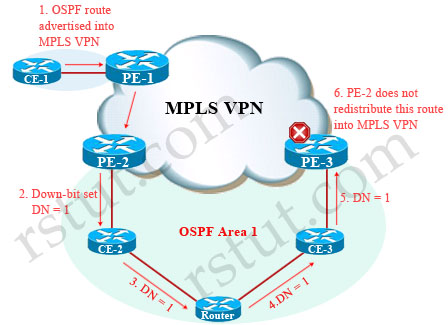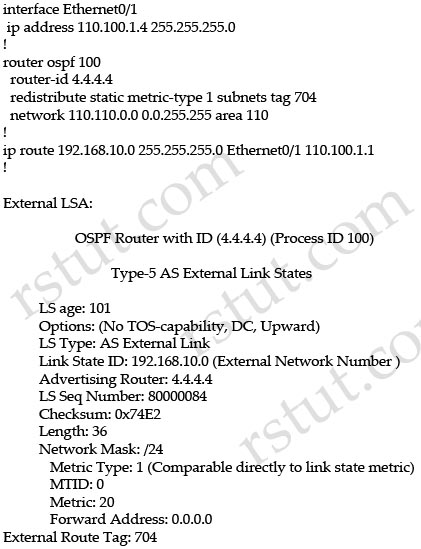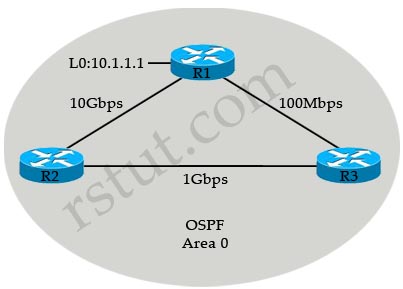OSPF Questions
Question 1
According to RFC 4577, OSPF for BGP/MPLS IP VPNs, when must the down bit be set?
A when an OSPF route is distributed from the PE to the CE, for Type 3 LSAs
B. when an OSPF route is distributed from the PE to the CE, for Type 5 LSAs
C. when an OSPF route is distributed from the PE to the CE, for Type 3 and Type 5 LSAs
D. when an OSPF route is distributed from the PE to the CE, for all types of LSAs
Answer: C
Explanation
If an OSPF route is advertised from a PE router into an OSPF area, the Down bit (DN) is set. Another PE router in the same area does not redistribute this route into iBGP of the MPLS VPN network if down is set.

The RFC 4577 says:
“When a type 3 LSA is sent from a PE router to a CE router, the DN bit in the LSA Options field MUST be set. This is used to ensure that if any CE router sends this type 3 LSA to a PE router, the PE router will not redistribute it further. When a PE router needs to distribute to a CE router a route that comes from a site outside the latter’s OSPF domain, the PE router presents itself as an ASBR (Autonomous System Border Router), and distributes the route in a type 5 LSA. The DN bit [OSPF-DN] MUST be set in these LSAs to ensure that they will be ignored by any other PE routers that receive them.”
For more information about Down bit according to RFC 4577 please read more here: http://tools.ietf.org/html/rfc4577#section-4.2.5.1.
Question 2
Refer to the exhibit.

Which option explains why the forwarding address is set to 0.0.0.0 instead of 110.100.1.1?
A. The interface Ethernet0/1 is in down state.
B. The next-hop ip address 110.100.1.1 is not directly attached to the redistributing router.
C. The next-hop interface (Ethernet0/1) is specified as part of the static route command; therefore, the forwarding address is always set to 0.0.0.0.
D. OSPF is not enabled on the interface Ethernet0/1.
Answer: D
Explanation
From the output of the “show ip ospf database” command (although this command is not shown) we can conclude this is an ASBR (with Advertising Router is itself) and E0/1 is the ASBR’s next hop interface for other routers to reach network 192.168.10.0.
The Forwarding Address is determined by these conditions:
* The forwarding address is set to 0.0.0.0 if the ASBR redistributes routes and OSPF is not enabled on the next hop interface for those routes.
* These conditions set the forwarding address field to a non-zero address:
+ OSPF is enabled on the ASBR’s next hop interface AND
+ ASBR’s next hop interface is non-passive under OSPF AND
+ ASBR’s next hop interface is not point-to-point AND
+ ASBR’s next hop interface is not point-to-multipoint AND
+ ASBR’s next hop interface address falls under the network range specified in the router ospf command.
* Any other conditions besides these set the forwarding address to 0.0.0.0.
-> We can see E0/1 interface is not running OSPF because it does not belong to network 110.110.0.0 0.0.255.255 which is declared under OSPF process -> F.A address is set to 0.0.0.0.
(Reference: http://www.cisco.com/c/en/us/support/docs/ip/open-shortest-path-first-ospf/13682-10.html)
Question 3
Refer to the exhibit.
| router ospf 100 router-id 4.4.4.4 area 110 nssa summary-address 192.168.0.0 255.255.0.0 nssa-only redistribute static metric-type 1 subnets tag 704 network 110.110.0.0 0.0.255.255 area 110 |
This is the configuration of the ASBR of area 110. Which option explains why the remote ABR should not translate the type 7 LSA for the prefix 192.168.0.0/16 into a type 5 LSA?
A. The remote ABR translates all type 7 LSA into type 5 LSA, regardless of any option configured in the ASBR.
B. The ASBR sets the forwarding address to 0.0.0.0 which instructs the ABR not to translate the LSA into a type 5 LSA.
C. The ASBR originates a type 7 LSA with age equal to MAXAGE 3600.
D. The ABR clears the P bit in the header of the type 7 LSA for 192.168.0.0/16.
Answer: D
Explanation
When external routing information is imported into an NSSA, LSA Type 7 is generated by the ASBR and it is flooded within that area only. To further distribute the external information, type 7 LSA is translated into type 5 LSA at the NSSA border. The P-bit in LSA Type 7 field indicates whether the type 7 LSA should be translated. This P-bit is automatically set by the NSSA ABR (also the Forwarding Address (FA) is copied from Type 7 LSA). The P-bit is not set only when the NSSA ASBR and NSSA ABR are the same router for the area . If bit P = 0, then the NSSA ABR must not translate this LSA into Type 5.

The nssa-only keyword instructs the device to instigate Type-7 LSA with cleared P-bit, thereby, preventing LSA translation to Type 5 on NSSA ABR device.
Note: If a router is attached to another AS and is also an NSSA ABR, it may originate a both a type-5 and a type-7 LSA for the same network. The type-5 LSA will be flooded to the backbone and the type-7 will be flooded into the NSSA. If this is the case, the P-bit must be reset (P=0) in the type-7 LSA so the type-7 LSA isn’t again translated into a type-5 LSA by another NSSA ABR.
Question 4
Which statement about OSPF multiaccess segments is true?
A. The designated router is elected first.
B. The designated and backup designated routers are elected at the same time.
C. The router that sent the first hello message is elected first.
D. The backup designated router is elected first.
Answer: D
Explanation
According to the RFC, the BDR is actually elected first, followed by the DR. The RFC explains why:
“The reason behind the election algorithm’s complexity is the desire for an orderly transition from Backup Designated Router to Designated Router, when the current Designated Router fails. This orderly transition is ensured through the introduction of hysteresis: no new Backup Designated Router can be chosen until the old Backup accepts its new Designated Router responsibilities.
The above procedure may elect the same router to be both Designated Router and Backup Designated Router, although that router will never be the calculating router (Router X) itself.”
(Reference: http://www.ietf.org/rfc/rfc2328.txt – [Page 76])
Question 5
Consider a network that mixes link bandwidths from 128 kb/s to 40 Gb/s. Which value should be set for the OSPF reference bandwidth?
A. Set a value of 128.
B. Set a value of 40000.
C. Set a manual OSPF cost on each interface
D. Use the default value.
E. Set a value of 40000000.
F. Set a value of 65535.
Answer: C
Question 6
Which statement about a type 4 LSA in OSPF is true?
A. It is an LSA that is originated by an ABR, that is flooded throughout the AS, and that describes a route to the ASBR.
B. It is an LSA that is originated by an ASBR, that is flooded throughout the AS, and that describes a route to the ASBR.
C. It is an LSA that is originated by an ASBR, that is flooded throughout the area, and that describes a route to the ASBR.
D. It is an LSA that is originated by an ABR, that is flooded throughout the AS, and that describes a route to the ABR.
E. It is an LSA that is originated by an ABR, that is flooded throughout the area, and that describes a route to the ASBR.
Answer: E
Explanation
LSA Type 4 (called Summary ASBR LSA) is generated by the ABR to describe an ASBR to routers in other areas so that routers in other areas know how to get to external routes through that ASBR.

Question 7
Which two functions are performed by the DR in OSPF? (Choose two)
A. The DR originates the network LSA on behalf of the network.
B. The DR is responsible for the flooding throughout one OSPF area.
C. The DR forms adjacencies with all other OSPF routers on the network, in order to synchronize the LSDB across the adjacencies.
D. The DR is responsible for originating the type 4 LSAs into one area.
Answer: A C
Explanation
DR originates the network LSA (LSA Type 2) which lists all the routers on the segment it is adjacent to -> A is correct.
Types 2 are flooded within its area only; does not cross ABR -> B is incorrect.
The broadcast and non-broadcast network types elect a DR/BDR. They form adjacencies to all other OSPF routers on the network and help synchronize the Link State Database (LSDB) across the adjacencies -> C is correct.
LSAs Type 4 are originated by the ABR to describe an ASBR to routers in other areas so that routers in other areas know how to get to external routes through that ASBR -> D is incorrect.
Note: To learn more about OSPF LSA Types, please read our OSPF LSA Types Tutorial.
Question 8
Refer to the exhibit.

Which two statements are true? (Choose two)
A. This is the output of the show ip ospf command.
B. This is the output of the show ip protocols command.
C. This router is an ABR.
D. This router is an ASBR.
E. Authentication is not configured for the area.
Answer: A E
Question 9
Refer to the exhibit.
| R1 ! interface Fastethernet0/0 ip address 10.1.1.5 255.255.255.0 ! router ospf 1 network 10.1.1.5 0.0.0.0 area 0 passive-interface default ! R2 ! interface FastEthernet0/1 ip address 10.1.1.6 255.255.255.0 ! router ospf 10 network 10.1.1.6 0.0.0.0 area 0 ! |
Which additional configuration is necessary for R1 and R2 to become OSPF neighbors?
A.
R1
!
router ospf 1
no passive-interface FastEthernet0/0
!
B.
R2
!
router ospf 10
no network 10.1.1.6 0.0.0.0 area 0
network 10.1.1.6 0.0.0.0 area 1
!
C.
R1
!
interface FastEthernet0/0
ip ospf mtu-ignore
!
R2
!
interface FastEthernet0/1
ip ospf mtu-ignore
!
D.
R1
!
no router ospf 1
router ospf 10
network 10.1.1.5 0.0.0.0 area 0
Answer: A
Question 10
Refer to the exhibit.

R3 prefers the path through R1 to reach host 10.1.1.1.
Which option describes the reason for this behavior?
A. The OSPF reference bandwidth is too small to account for the higher speed links through R2.
B. The default OSPF cost through R1 is less than the cost through R2.
C. The default OSPF cost through R1 is more than the cost through R2.
D. The link between R2 and R1 is congested.
Answer: A
Explanation
The default formula to calculate OSPF bandwidth is BW = Bandwidth Reference / interface bandwidth [bps] = 10^8 / / interface bandwidth [bps]
BW of the R1-R3 link = 10^8 / 100Mbps = 10^8 / 10^8 = 1
BW of the R2-R3 link = 10^8 / 1Gbps = 10^8 / 10^9 = 1 (round up)
Therefore OSPF considers the two above links have the same Bandwidth -> R3 will go to 10.1.1.1 via the R1-R3 link. The solution here is to increase the Bandwidth Reference to a higher value using the “auto-cost reference-bandwidth” command under OSPF router mode. For example:
Router(config)#router ospf 1
Router(config-router)#auto-cost reference-bandwidth 10000
This will increase the reference bandwidth to 10000 Mbps which increases the BW of the R2-R3 link to 10^10 / 10^8 = 100.
Question 11
Refer to the exhibit.

Why is the prefix 1.1.1.1/32 not present in the routing table of R1?
A. There is a duplicate router ID
B. There is a subnet mask mismatch on Ethernet0/0
C. The router LSA has an invalid checksum
D. There is an OSPF network type mismatch that causes the advertising router to be unreachable
Answer: D

With all respect sir, on question number 5
it’s said that ‘ Which value should be set for the OSPF’
In my opinion, the best from the best answer is B (not C) because the value shoulb be change to be 40000Mbps according to the highest bandwidth link.
Hello All. Why Q11 answer is D? Why do we see 1.1.1.1 in neighbors if RID is 10.10.10.10?
On Q5, the correct answer is C.
If you set your reference bandwidth to 40G then ever link with a speed of 610kbps or less will have an interface cost of 65535. This is the maximum metric you can have in OSPF as the metric field is only 16 bits. While this is still a valid metric, it is not good to have in your network. Also keep in mind that virtual-links which have a cost of 65535 will go down, sucks if you were to have a low cost link in the path… In this case, it would be best to manually configure the costs on the links so that low costs links do not have a cost of max-metric.
The LSA from Router-ID 1.1.1.1 has one stub network (loopback) and one transit link. A transit link is a link with a network type that uses DR/BRD (broadcast, non-broadcast). A transit link will be associated with a Type-2 LSA. The output of the show ip ospf neighbor tells us that our neighbor with the Router-ID 1.1.1.1 and a physical address of 10.1.1.1 is in a Full/- state. The ‘-‘ means that we are not configured to use DR/BDR with the neighbor (point-to-point, point-to-multipoint). Therefore the neighbor (1.1.1.1) is configured to use DR/BDR and this router is configured to NOT use DR/BDR. There is a network type mismatch.
You can mix/match network types as long as both sides support DR/BRD, note that you will have to change the timers to make them work. Example, broadcast(DR/BRD) can be matched with non-broadcast(DR/BDR) as long as you change the timers. Point-to-Point can be matched with Point-to-multipoint as neither side supports DR/BDR. Point-to-point can NOT be matched with broadcast as one side uses DR/BDR while the other side does not.
Hey, Question 1
Shouldn’t the right answer be A?… Down bit is only set for Type 3 LSAs. As a matter of fact, when a PE router advertises Type 3 LSAs with the down bit set to a CE router and the CE router drops this advertisement, you can force the CE to accept the routes by changing the OSPF domain ID on the PE, which will make the LSAs become type 5 and in turn the CE will accept them. Another option is to enable the “vrf capability lite” on the CE so they become Type 1 LSAs. Please advise!!!
Evil, while you are correct in your understanding, the correct answer is still C. Per RFC 4577 BOTH type-3 and type-5 LSAs shoud set the down-bit. Cisco implementation is different and only sets the down-bit on type-3 LSAs. RFC 4577 section 4.2.5.2 talks about using route-tags to prevent loops in type-5 LSAs. This is how cisco cisco implements it.
The questions asks about the RFC, not how Cisco implements it.
In new IOS code, down bit for type 5 LSA is supported.
Q9: Why Answer A. R2 has not “router OSPF 1” but 10 and cannot form neighborship with R1 even after changing the INT in R1 from passiv to activ. Answer D looks to be correct. if not please explain!!!! thankyou
For Q9). Below conditions must match for ospf routers to become adjacency.
1. Area ID. 2. Hello interval 3. Dead interval.
4. Authentication(if configured) 5. Ospf stub area type.
Noted: ospf process ID does not need to be match.
R1 enable ospf for int fa0/0, but R1 passive all the ospf interfaces. That means no hello package will be send out from fa0/0. So neighbor adjacency will not form. Once you no passive interface fa0/0. R1 and R2 will form adjacency.
Let me know if you still have doubt.
Regarding Q10) i think A and B both are true
For Q2, the answer is correct though but the command used is the “show ip ospf database summary”
q1 answer is wrong the down bit is set only for lsa 3 it should be A for lsa 5 the loop prevention is include in the tag which encodes the as is in decimal and convert it in hex the last two number and convert in decimal you will see the as number . show ip ospf database
q1 —
In order to overcome this situation, when the routes are redistributed from MP-BGP into OSPF, then they are marked with a DN Bit in LSA Type 3, 5, or 7 .
I am sharing from cisco website
re Q7
Shouldn’t the answer be AB instead of AC?
“B. The DR is responsible for the flooding throughout one OSPF area.”
To me this sounds correct, since the DR uses frequency 224.0.0.5 to send updates, and all DROTHER routers are tuned to that frequency, thus it’s flooding.
“C. The DR forms adjacencies with all other OSPF routers on the network, in order to synchronize the LSDB across the adjacencies.”
It forms adjacencies with all other OSPF routers in the AREA, not network.
Q7.
I also believe AB is correct instead of AC.
“… flooding throughout one OSPF area” does not imply crossing the ABR; therefore Type 2 LSAs are flooded within its area. –> B is correct
A is correct since the DR originates the network LSA (type 2 LSA) in its area.
Hi dudes,
For OSPF these questions is good but not enough. Check the whole lessons’s summary 😉
http://ipcisco.com/ospf-open-shortest-path-first-part-1/